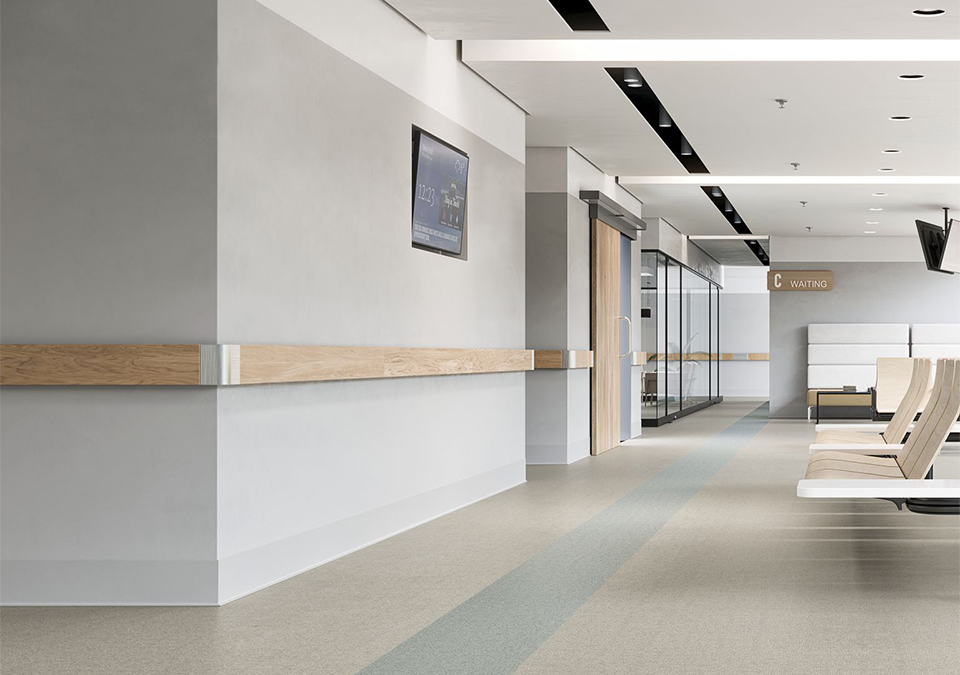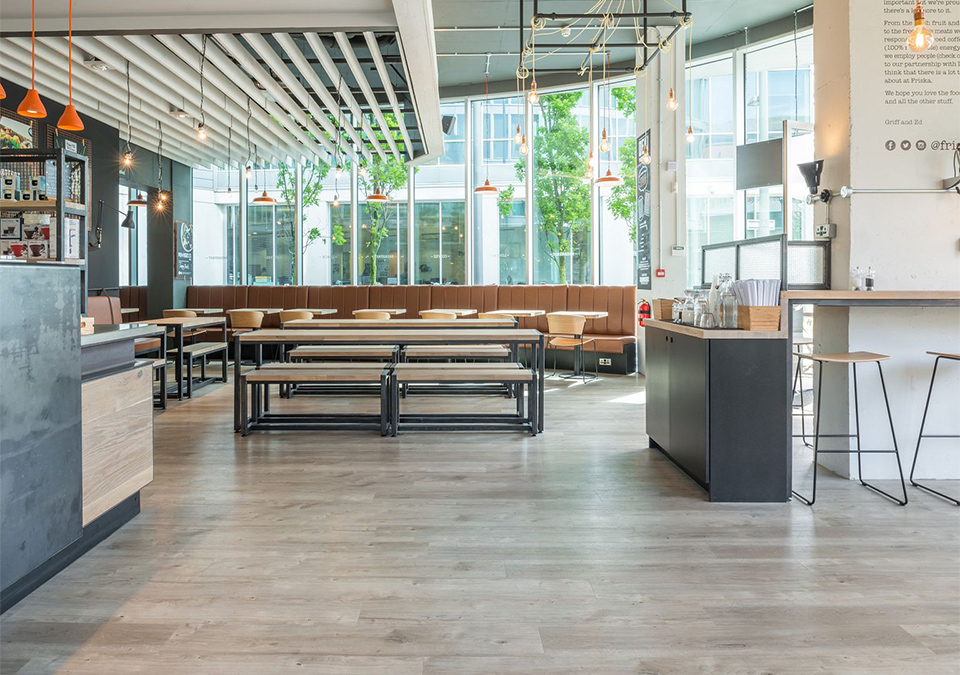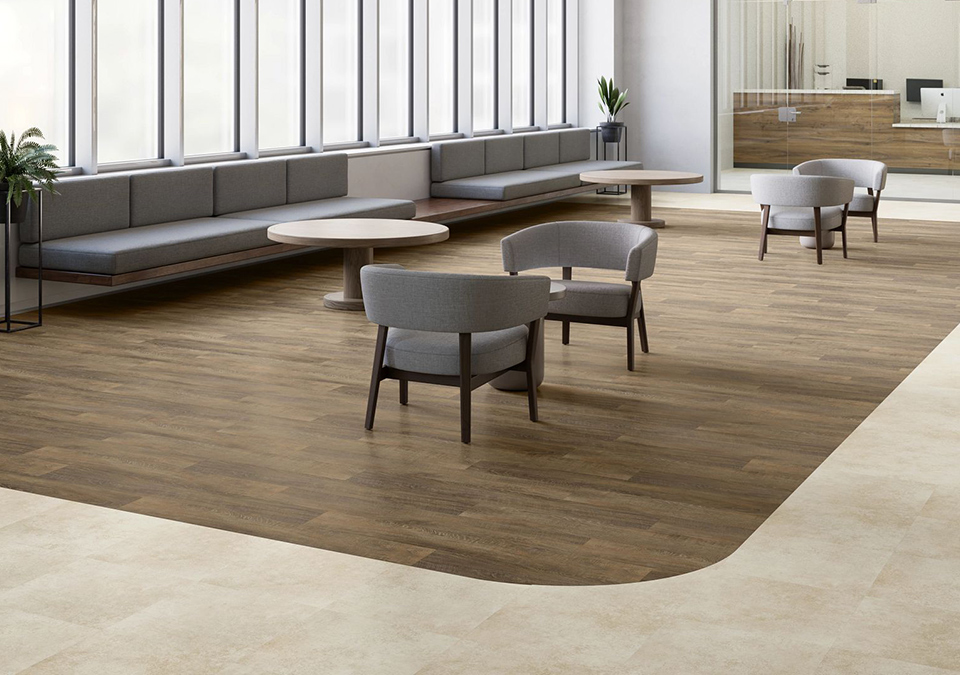
Solving Moisture-Related Commercial Flooring Issues
September 26, 2024Imagine walking into a bustling airport. To many of you, the smooth floors allow you to glide your suitcase effortlessly. For travelers in wheelchairs, this type of flooring isn’t just convenient, it allows them to navigate without difficulty. This is the result of thoughtful design – where flooring isn’t just about looks but accessibility for everyone.
Creating accessible and inclusive public spaces is vital to ensuring that everyone can navigate comfortably, regardless of their abilities. Flooring plays a crucial role in this. The Americans with Disabilities Act (ADA) sets guidelines to ensure public spaces are equipped with flooring that is firm, stable, and slip-resistant, accommodating individuals with mobility aids like wheelchairs. Here’s how the right commercial flooring can enhance accessibility and inclusivity:
Slip Resistance
Safety is paramount in any public setting, and slip-resistant flooring plays a crucial role in preventing falls, particularly for individuals with mobility challenges, seniors, and young children. Selecting materials such as vinyl, rubber, and textured surfaces can provide excellent slip resistance and ensure that everyone can navigate the space confidently. These surfaces reduce the likelihood of accidents, not only in high-traffic areas but also in places like ramps and areas where water is frequently present, such as produce sections in grocery stores. By implementing slip-resistant flooring in these areas, you create an environment where users can focus on their activities without worrying about potential hazards.
Smooth Transitions
For individuals who use wheelchairs or other mobility devices, flooring that is smooth and level is essential. Uneven surfaces, thick carpets, and raised thresholds can create significant obstacles and impede movement. Seamless transitions between different types of flooring, such as from tile to carpet or vinyl, facilitate easier navigation for all users. This attention to detail not only aids those with mobility challenges but also enhances the overall experience for everyone, promoting a more inclusive environment.
Durability and Maintenance
Public spaces are subject to heavy foot traffic, making the durability of flooring an essential consideration. Options like vinyl, linoleum, and rubber are not only long-lasting but also easy to maintain, making them ideal for high-traffic areas such as hospitals, malls, and airports. Popular ADA-compliant flooring options like hardwood, laminate, ceramic, and vinyl not only ensure safety and accessibility but also provide durability, according to StrongGo. Choosing resilient flooring materials ensures that these spaces remain attractive and functional over time, reducing the need for frequent replacements and minimizing disruptions to the public.
Acoustic Considerations
Excessive noise can be particularly overwhelming for individuals with sensory sensitivities. Soft flooring materials, such as carpet or acoustic-friendly options, can absorb sound and minimize noise levels, creating a more comfortable atmosphere for everyone. This consideration is especially important in environments like schools, healthcare facilities, and retail spaces, where a calming atmosphere can significantly enhance the overall experience for all.
Color & Texture Contrast
Establishing a clear color contrast between floors and walls is crucial for aiding visually impaired individuals in navigation. High-contrast materials and textures allow people to distinguish key elements through both sight and touch. According to ArchDaily, architects are increasingly using contrasts in materials, such as wood floors against white walls, to enhance spatial awareness. Thoughtfully designed color schemes not only enhance accessibility but also contribute to the aesthetic appeal of the space, creating an inviting atmosphere for all.
Environmental Considerations
When selecting commercial flooring with accessibility and inclusivity in mind, environmental considerations are key for creating healthier spaces. Sustainability can be achieved by choosing eco-friendly materials like bamboo, cork, reclaimed wood, or recycled vinyl, which have a lower environmental impact. FeatureFlooring says it’s also important to look for flooring products that have undergone a lifecycle assessment to minimize waste and resource consumption.
Additionally, selecting durable flooring reduces the need for frequent replacements, contributing to sustainability. Opting for natural, low-VOC (volatile organic compounds) materials helps improve indoor air quality, benefiting individuals with sensitivities or respiratory issues. This ensures a comfortable atmosphere for all users and encourages engagement in public areas. By prioritizing these environmental factors, businesses can create inviting spaces that promote well-being while fulfilling ethical responsibilities.
Choosing the right flooring for public spaces goes beyond aesthetics. It’s about creating environments where all people, regardless of ability, can feel safe and included. With the right flooring materials, commercial spaces can be both functional and welcoming for everyone.
At CFIC, we understand that creating accessible and inclusive public spaces is vital for ensuring that everyone can navigate comfortably, regardless of their abilities. Our flooring experts are here to guide you in selecting the right solutions that prioritize safety, durability, and aesthetics. Whether you’re considering an upgrade to enhance accessibility or embarking on a new project, we can help you make informed decisions tailored to your unique requirements. Contact us today to discuss how we can assist you in fostering inclusivity through exceptional flooring solutions.
*Photo courtesy of Mannington Commercial.




